介绍
安装中 LED显示屏 in places with high traffic volume can not only improve the efficiency of information dissemination but also add highlights to the environment. But do you know?
There is actually a lot of knowledge in this! So, how can we ensure that the LED display screen operates safely, efficiently, and beautifully in a busy environment? This article will answer them one by one for you.
目录
Item 1: Preparation and planning before installing the LED display screen
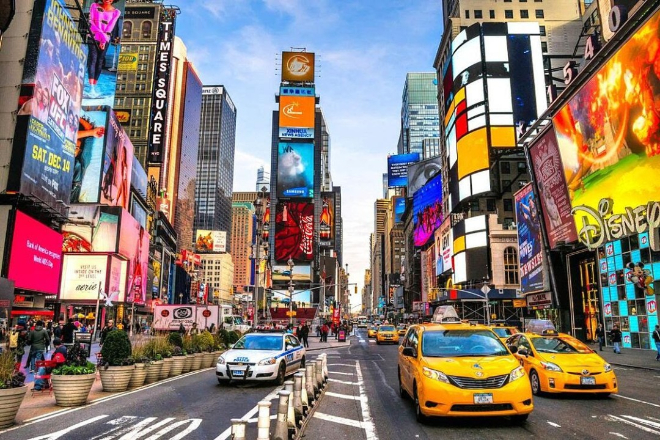
1). Space size
Before installing the LED display screen, you must go to the site to take a look and measure the length, width and height of the installation location.
This is very important because you must ensure that the display screen can be placed, and there must be enough space around it for heat dissipation, maintenance, and operation.
If it is installed on the wall, you must also see if the wall can bear the weight of the display screen. If you have any questions, it is best to find a professional to see it.
In addition, you must also pay attention to whether there are any obstructions around, such as large trees, pillars, etc., which may block the screen image.
Also, you have to see what the surrounding light is like. If the light is too strong, you have to consider using a brighter display screen.
2). 电源 conditions
The power supply is a very critical part. In foreign countries, the voltage standard may be different from that in China. Common voltages are 110V, 220V or 240V, depending on the local power grid conditions.
First, check whether the voltage on site is stable and whether it meets the requirements of the display screen.
You also have to check whether the power capacity is sufficient because the display screen, control system, air conditioner, fan, and other equipment used together may require a lot of electricity.
The layout of the power cord is also very important. If the line is too long, it may cause insufficient voltage, and it is best to hide the line. Otherwise, it will not only be unsightly but also may trip people.
Grounding is also very important. The display screen must be grounded to ensure safety. Generally, the grounding resistance should be less than 4 ohms.
3). Network Access
If the display screen needs to be connected to the Internet, such as remote control or receiving data, then the network situation must be checked carefully.
You can use professional tools to measure the signal strength to ensure that the signal is stable.
You also need to see whether it is a wired network or a wireless network. If it is wired, you have to see where the network cable interface is and whether it can be easily connected to the display screen.
If it is wireless, you must ensure that the signal can cover the installation location. If the signal is not good, you may need to add a signal amplifier.
In addition, you also need to see if the network bandwidth is sufficient. If the bandwidth is too small, the video playback on the display may be stuck.
4). Other environmental factors
In addition to the above, there are some other factors to pay attention to. For example, temperature and humidity.
If the installation location is too hot or too humid, it may affect the life of the display. At this time, you may need to install an air conditioner or dehumidifier.
You also need to see if there are any safety hazards around, such as flammable materials or dangerous chemicals, which must be kept away from the display.
In addition, the height and location of the display installation must also be considered for safety, such as not allowing people to easily climb or touch it.
Item 2: Accurate adjustment of the installation position of the LED display
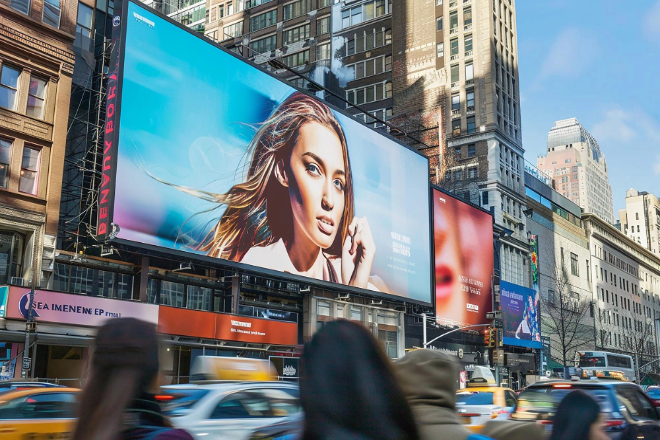
Although the approximate location of the installation site has been determined, the display’s position still needs to be carefully adjusted during the specific installation.
This step is very important because only when the position is adjusted can the display effect be ensured to be optimal.
1). Adjustment of the relative position with surrounding objects
When installing the LED display, be sure to pay attention to the surrounding environment, especially the relative position with surrounding buildings, billboards, street lights, and other objects.
First of all, avoid blocking and carefully observe whether there are other objects around that may block the screen of the display.
For example, if there are protruding parts of buildings or tall billboards nearby, make sure there is enough distance between the display and them so that the audience can see the full picture.
Visual coordination should also be considered. The height and angle of the display should not appear abrupt and should be as harmonious as possible with other objects in visual terms.
If there are other billboards around, the height of the display should be similar to them so that it looks more natural.
Through these adjustments, the display can be better integrated into the environment while ensuring that its display effect is not disturbed.
2). Adjust the orientation of the display according to the direction of traffic
Observing the direction of traffic at the installation location is the key to adjusting the orientation of the display.
Carefully study which direction people pass by, such as at the entrance of a shopping mall, whether people walk from left to right or from right to left.
On the side of the street, in which direction people pass by. After understanding the direction of traffic, you can adjust the orientation of the display according to this direction so that the audience can see the content of the display for the first time while walking.
If the display is not oriented correctly, the audience may need to turn their heads or turn in order to see the picture, which will affect the viewing experience.
By adjusting the orientation of the display screen to match the direction of the flow of people, you can maximize the attention of the audience and enhance the communication effect of the display screen.
3). Adjust the angle of the display screen according to the audience’s line of sight
The height and angle adjustment of the display screen are crucial to the audience’s viewing experience.
First, consider the average height and viewing habits of the audience, and adjust the height of the display screen so that the audience can see the picture at eye level.
Generally speaking, the center position of the display screen is best to be about the same as the average line of sight of the audience, so that the audience will not feel uncomfortable when watching.
Secondly, the angle of the display screen also needs to be fine-tuned. If the audience passes from the side, the angle of the display screen may need to be slightly tilted so that the picture does not look distorted.
The bracket or mounting bracket of the display screen can be adjusted to keep the picture in the best state from the audience’s perspective.
Through these meticulous adjustments, you can ensure that the audience can get a good viewing experience at any position.
4). Precautions in actual operation
When actually adjusting the position and angle of the display screen, it is recommended to find a few more people to help test.
Let people of different heights and different positions look at the picture effect of the display screen to see if there is any obstruction and whether the viewing angle is appropriate.
If you find a problem, adjust it in time. Sometimes, the first adjustment may not be perfect and you need to adjust it repeatedly several times.
For example, after adjusting the height, you may need to fine-tune the angle; after adjusting the angle, you may need to check the coordination with surrounding objects.
Therefore, be patient and adjust repeatedly until you find the best position.
After the adjustment is completed, remember to record the results of the adjustment, such as the height, angle, and relative position of the display screen to other objects.
In this way, if maintenance or adjustment is required in the future, you can quickly find the previous settings.
Through these meticulous operations, you can ensure that the installation effect of the display screen is optimal.
Item 3: Safe layout of power supply and lines of LED display screens
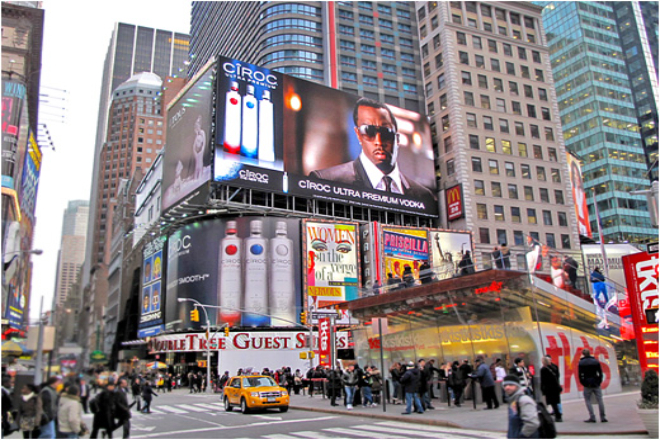
When installing LED display screens in places with large traffic, the safe layout of the power supply and lines is crucial.
A complex environment, unstable power supply, or improper line layout will not only damage the display screen but also may cause safety accidents. Here are some key points:
1). Ensure stable and reliable power supply
The power supply is the core of the display screen and must be stable and reliable. The voltage is commonly 110V, 220V, or 240V. Choose the appropriate voltage according to the local power grid.
Installing a voltage stabilizer can avoid voltage fluctuations, ensure sufficient power capacity, and avoid equipment overload.
Before installation, the total power should be calculated to ensure that the power supply can meet the power requirements of all equipment.
2). Line layout should be standardized
The line layout should avoid being exposed to prevent being stepped on or damaged. All lines should be protected by wire troughs or wire pipes and fixed firmly.
The line direction should be reasonable and hidden as much as possible to avoid looseness and virtual connection. After the connection is completed, wrap it with insulating tape to ensure safety.
3). Waterproof and lightning protection measures for 户外LED显示屏
Outdoor display screens need to pay special attention to waterproofing and lightning protection.
The display screen housing should have a waterproof function, and the waterproof level is recommended to reach IP65 or above.
The power supply and line interfaces should be sealed and waterproof, and waterproof tape or waterproof connectors should be used.
In terms of lightning protection, lightning rods should be installed and ensure good grounding, with a grounding resistance of less than 4 ohms.
It is recommended to use shielded wires for power lines and signal lines, and install lightning arresters.
4).定期检查和维护
Regularly check whether the power line, signal line and control line are aging or damaged, and replace them in time if problems are found.
Check whether the power supply equipment is working properly to ensure stable power supply.
Outdoor display screens should be regularly checked for waterproof and lightning protection facilities, especially before bad weather, to ensure the safety of the equipment.
Item 4: Fixing and structural stability of LED display screens
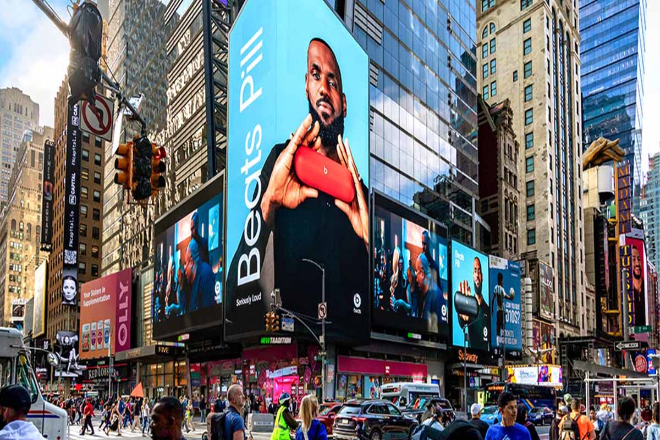
When installing LED display screens in places with large traffic, whether they are fixed firmly and whether the structure is stable is a big deal!
In places where people come and go, the display screen is easy to be bumped. If it is not installed properly, the display screen will sway or even fall down, which will be troublesome.
Therefore, when installing the display screen, you must pay special attention to fixing it; don’t save trouble!
1). Use brackets and fixings well
When installing the display screen, the brackets and fixings must not be sloppy. The bracket must be strong and can steadily support the weight of the display screen.
If the bracket is too small or too weak, the display screen will be like swaying in the wind when placed on it, and it may fall at any time.
The fixings must also be selected with good quality bolts and nuts to fix the display screen firmly. When installing, be sure to follow the instructions and tighten each screw without loosening.
If you save trouble and screw fewer screws, that won’t work! After installation, it is best to check again to see if there are any places that have been screwed in.
2). Make sure the display is installed firmly
During installation, spend more time to ensure that the display is stable in all directions. Especially for large displays, it is better to use more fixing points, which is safer.
After installation, gently push the display to see if it shakes. If you find it loose, don’t make do with it, and fix it again immediately.
Otherwise, the display may have problems in a short time. If conditions permit, you can use tools such as a level to ensure that the display is installed neatly, which is not only beautiful but also more stable.
3). Test the strength of large displays
For particularly large displays, conventional installation alone is not enough. It is best to do a simple strength test, such as gently bumping or shaking it to see if the display will loosen.
If conditions permit, you can ask professionals for help to ensure that the display can withstand some small collisions.
For example, you can use some soft materials to gently bump the display to see if it will shake or shift. If you find any problems, adjust them in time, so that you can feel at ease.
4). Check the fixing situation regularly
Even if it is installed firmly at the beginning, the display screen may become loose after a long time. Especially in places with a large flow of people, the display screen is often touched, so it should be checked regularly.
Spend some time every month to check whether the brackets and fixings are loose, deformed, or broken.
If you have problems, repair or replace them in time so that the display screen will always be stable.
If you find that the bracket is rusted or the screws are loose, don’t delay and deal with them immediately, otherwise the problem will become more and more serious.
Item 5: Noise and dust control during the installation of LED display screens
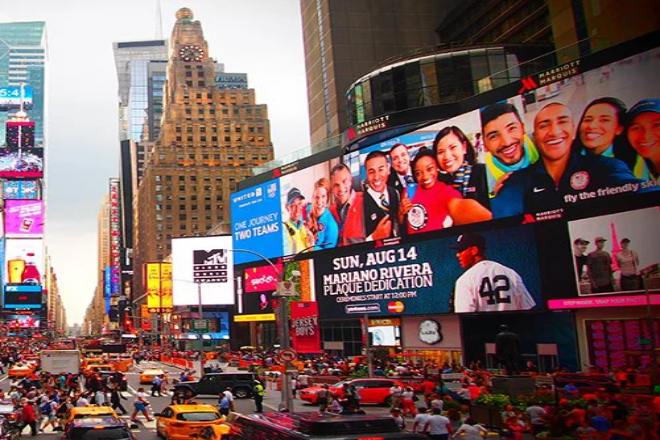
When installing LED display screens in places with a large flow of people, the noise and dust problems during the construction process cannot be underestimated!
Think about it: if the machine rumbles non-stop during construction and dust flies all over the sky, the people around will definitely be upset.
Therefore, you must spend more time on construction, try to control the noise and dust as much as possible, and don’t cause too much trouble to everyone.
1). Reasonable arrangement of construction time
The choice of construction time is really important. In places with a large flow of people, during the day, especially during commuting time, people come and go.
If construction is carried out at this time, the noise and dust will definitely affect the people around.
Therefore, it is best to choose a time when there are fewer people to carry out construction, such as in the morning when everyone has not yet gone out or in the evening when everyone is off work and there are not so many people on the street.
This will not only reduce the interference of pedestrians but also make construction smoother.
If there is really no way to avoid peak hours, try to arrange the noisy processes when there are fewer people, such as cutting and drilling operations, and try to do them at night or on weekends.
2). Use low-noise equipment
There are many low-noise equipment on the market now. Although the price may be a little more expensive, it is really different to use.
For example, choose a quieter electric drill or use a cutting machine with a noise-reduction function. These devices can greatly reduce noise.
Although it costs more money, it is worth it to have fewer complaints from people around. Moreover, using low-noise equipment for construction will also keep your ears quiet, and the construction workers will thank you.
If you can find second-hand low-noise equipment, it will be more cost-effective, saving money and reducing noise.
3). Set up fences and dust covers
During construction, dust can easily fly everywhere, which is not only uncomfortable, but also may make things around dirty.
Therefore, it is best to build a fence around the construction area to separate the construction area from the pedestrian passage.
You can use a light but strong plastic sheet or a metal fence, which can block the dust without affecting pedestrian traffic.
For those equipment that is prone to dust, such as cutting machines, you can cover them with dust covers so that the dust will not fly everywhere.
If conditions permit, you can also spray some water on the fence so that the dust will not easily float away.
4). Keep the construction site clean
During the construction process, some garbage and dust will inevitably be generated. Construction workers must develop good habits and clean up the construction area at any time to prevent garbage and dust from accumulating.
You can prepare some brooms, dustpans, and vacuum cleaners to clean the construction area at any time. If there is too much dust, you can also sprinkle some water on it to reduce dust.
After the construction is completed, be sure to clean it thoroughly and clean up the construction site so that people around will be more comfortable. If you can clean it regularly, such as once every two hours, the effect will be better.
5). Communicate well with people around you
Before construction, it is best to say hello to people or businesses around you and tell them the approximate construction time and possible impact.
For example, put up a notice in advance to tell everyone “Construction is going to be done here, it may be a bit noisy, please bear with me.”
In this way, everyone will know what is going on and understand that your construction is for better facilities.
If someone has questions, explain patiently and win their support. If you can establish a good relationship with people around you, the construction process will be smoother.
6. 结论
Through the introduction of this article, I believe you have a more comprehensive understanding of installing LED display screens in places with high traffic.
Careful planning in the early stage and meticulous operation during the installation process is the key to ensuring the stable operation of the display screen.
I hope these practical suggestions can help you complete the installation smoothly and make the LED display screen play the best effect.
最后,如果您想了解更多关于LED显示屏的知识, 请与我们联系.
